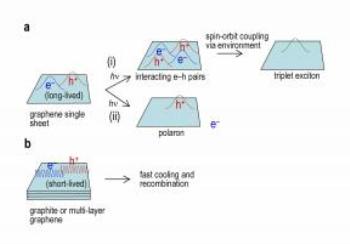Graphene has the tendency to stack together to form graphite. A method developed by scientists from the University of Cambridge, DSO National Laboratories and the National University of Singapore (NUS) prevents graphene sheets from re-stacking by bonding alkyl surface chains on them, while maintaining the characteristics of their nano-graphene pockets.
 The new optical-induced absorption mechanisms [a] Photoexcitation of a dispersed graphene single sheet gives long-lived electron-hole pairs. Further excitation causes the appearance of localized states such as (i) excitons (neutral excited state) or (ii) polarons (charged excited state) due to interactions. [b] For comparison, graphite gives on electron-hole gas that is very short-lived due to fast cooling and re-combination. (Credit: National University of Singapore)
The new optical-induced absorption mechanisms [a] Photoexcitation of a dispersed graphene single sheet gives long-lived electron-hole pairs. Further excitation causes the appearance of localized states such as (i) excitons (neutral excited state) or (ii) polarons (charged excited state) due to interactions. [b] For comparison, graphite gives on electron-hole gas that is very short-lived due to fast cooling and re-combination. (Credit: National University of Singapore)
A novel material, which can be dissolved in film matrices and solvents and can be treated in a solution, has been synthesized by this innovative technique. Consequently, the scientists discovered that the dispersed graphenes demonstrate a giant non-linear optical-absorption phenomenon to powerful nanosecond laser pulses for a broad array of spectrum with a very low threshold value when compared to that observed in carbon nanotubes or carbon black suspensions, resulting in a record energy limiting onset value of 10 mJ/cm2 for 70% of linear transmittance.
As per the mechanism behind this novel phenomenon, the originally delocalized electron-hole gas gets localized at high-excitation densities when heavy atoms were present, resulting in the production of powerful absorbing excitons. These optical limiting materials find applications in anti-glare treated devices, optical circuits and protecting sensitive sensors and equipment from laser damage.
Professor Geok-Kieng Lim, who serves as an Adjunct Professor of NUS Department of Physics and is the principal investigator of DSO National Laboratories’ graphene team, stated that it realizes the production of useful graphene nano-composite films for use that demands completely dispersed graphene sheets.
Professor Lay-Lay Chua, who is the principal investigator of the graphene team at the NUS Organic Nano Device Laboratory stated that using ultrafast spectroscope, the researchers observed a behavior change of the dispersed graphene sheets from induced optical transparency to induced optical absorption based on its surroundings.